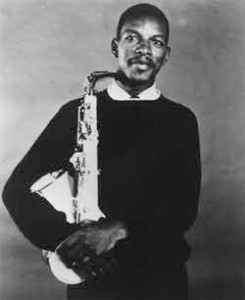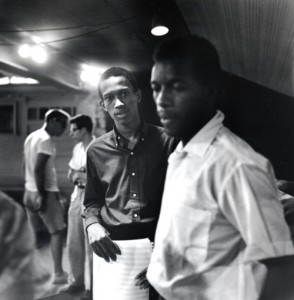1959 was a watershed year for jazz music (arguably the greatest single year for jazz in all history–which is saying a lot). Here’s a taste: Miles Davis Kind of Blue, John Coltrane Giant Steps, Charles Mingus Ah Um. That is like the holy trinity of jazz music; all from the same year. But in the not-so-silent shadows a young, relatively unknown alto saxophonist was poised to cause a stir that still reverberates today: Ornette Coleman’s provocatively titled The Shape of Jazz to Come.
Kind of Blue is correctly celebrated for establishing modal music, and a genuine evolution from bop and post-bop; Giant Steps is the apotheosis of the “sheets of sound” that John Coltrane had been practicing and perfecting for a decade; Ah Um is an encyclopedic history of jazz music, covering everyone and everything from Jelly Roll Morton to Duke Ellington. And each of those albums were immediately embraced, and remain recognized as genuine milestones today. But The Shape of Jazz to Come was incendiary and complicated: it inspired as much resistance as it did inspiration. Some folks (Mingus included) bristled that it was all so much sound and fury, signifying…little. But what Coleman (along with trumpet player Don Cherry, bassist Charlie Haden and drummer Billy Higgins — representing as solid a quartet as any that have made music, ever) achieved was, arguably, the most significant advancement since Charlie Parker hit the scene.
Of course, Parker was also misunderstood and dismissed when his frenetic, almost incomprehensibly advanced alto saxophone assault began to cause scales to drop from audiences’ eyes — if not their ears. Like any genuine iconoclasts of the avant garde, Parker and Coleman were not being new for newness sake; they had to fully grasp and master the idiom before they could transcend it. Tellingly, what was revolutionary and almost confrontational, then, seems rather tame and entirely sensible, now. Of course, it didn’t take 50 years for Coleman to resonate: he not only found his audience, John Coltrane –the all-time heavyweight champion– embraced his compatriot. He endorsed, and, crucially, he imitated. The Book of Revelation that Coltrane’s mid-’60s Impulse recordings comprise did, in many respects, grow directly out of the opening salvo fired by Coleman in ’59.
Perhaps the best known tune of the six originals is the opening track, “Lonely Woman”. It’s been established as a standard and has been covered by artists ranging from Billy Bang to Branford Marsalis (both of these efforts, incidentally, are sprawling, impressionistic extensions of the original; if the original is impossible to improve upon, both of these artists took Coleman’s diamond and added grit, depth and layers of feeling). “Lonely Woman” is, suffice it to say, a touchstone that myriad jazz musicians reference, turn to and worship, for understandable reasons.
Why? It is an uncanny composition, deceptively simple and almost unbearably emotional. In fact, I’m not sure I could think of another jazz performance that captures the visceral nature of human pain so poignantly. Of course it’s much more than that: as the title suggests, it certainly gives voice to a person in distress; it also conveys a more universal expression –one that is very vulnerable and distinctly personal. It achieves what our best art aspires to: an invocation of real experience, which is then enlarged and elevated so that it is at once part of us and much bigger than any one of us is capable of being. It renders perfect and profound what is so often otherwise flawed and feeble: our attempts to articulate what we most love and fear –especially when no one else is around.
So: here are three versions spanning five decades. The first, and indelible original from O.C. The second, a somewhat whimsical homage from John Zorn. Finally, the amazing Dave Liebman utilizing the wood flute to bring an added sense of adventure and exotica. It is this last version that reminds me, again, that every time we may think we’ve heard everything or imagined anything worth thinking about, there are sensitive and brilliant souls amongst us who are capable of making us see the world with new ears.
Ornette Coleman (1959):
John Zorn (1989):
David Liebman (2010):


